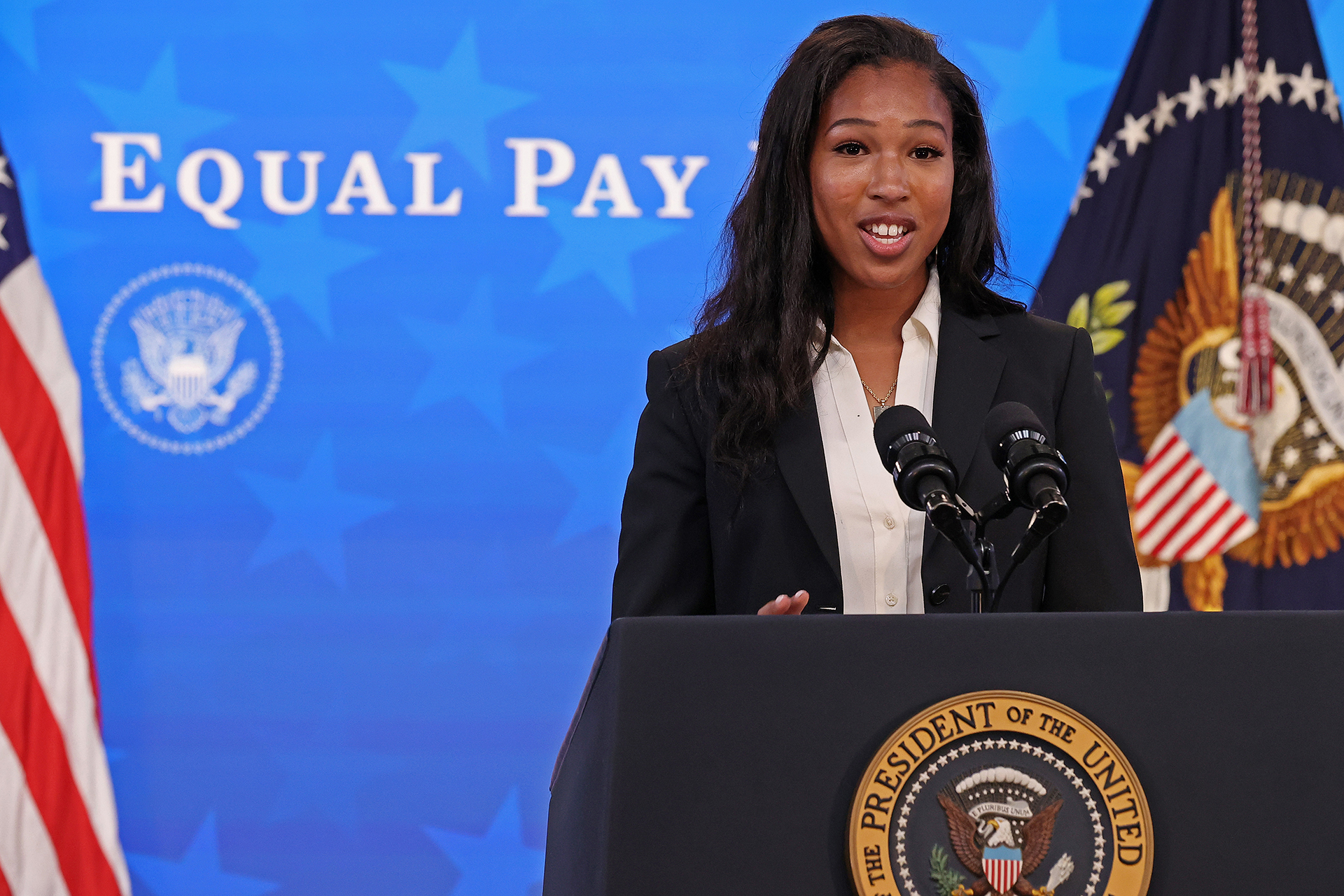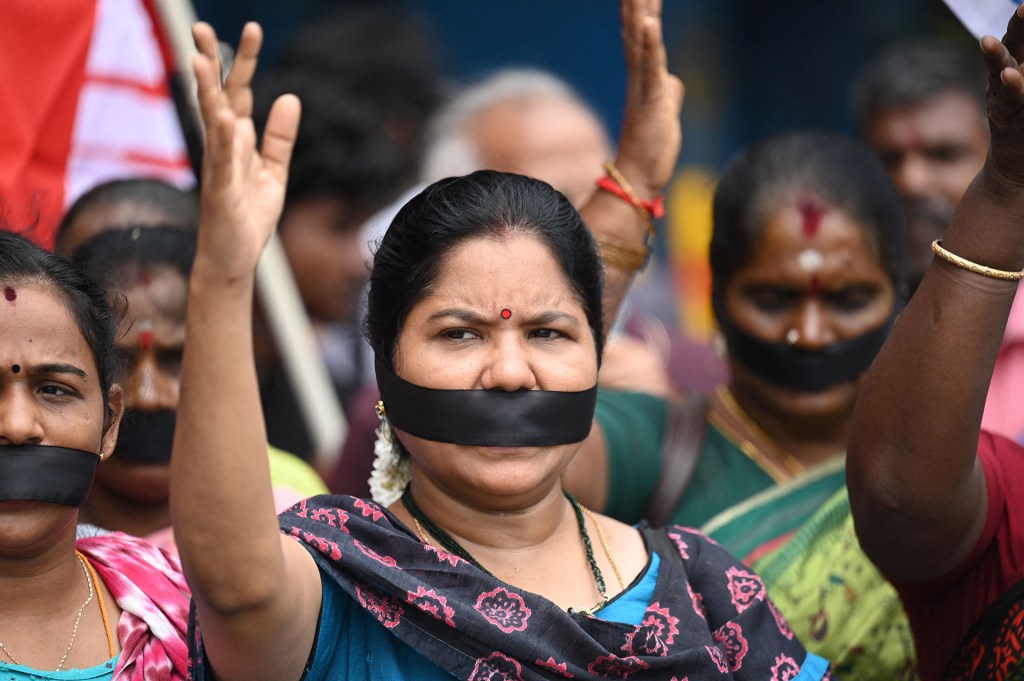In 2016, five star players from the United States women’s national soccer team decided they had had enough. They were tired of a system that did not value their hard work as much as it applauded and awarded soccer when played by men. For years, in fact, the women players had been paid significantly less than their counterparts on the men’s national team—even when they scored much bigger victories, including winning the 2015 World Cup. It was time to change the game.
In a federal equal pay complaint, the five athletes said they were always paid thousands of dollars less than their male equivalents, no matter the competition or crowd size. In March 2019, after the U.S. men’s soccer team failed to qualify for the 2018 World Cup, 28 players from the women’s team filed a gender discrimination lawsuit over pay equity and working conditions. A federal judge dismissed parts of the lawsuit the next year, but the women’s team players ultimately secured a settlement even though U.S. Soccer was not obligated to provide one.
In February 2022, after six years of litigation, the women finally had cause for celebration: U.S. Soccer announced that the men’s and women’s teams would be paid equally. Megan Rapinoe, the women’s team captain, called it a “huge win,” adding, “We are really in the midst of an incredible turning point in women’s sport.”
We celebrated this victory off the field and hoped it would create a ripple effect beyond athletics. After all, a growing body of research shows that everyone wins when we advance women’s rights, and a recent global study shows that both men and women are likely to live longer when a country makes strides toward gender equality.

Closing the gender pay gap in sports—and every other sector—is a powerful step forward. At the same time, we know it is just the beginning of a long, bumpy road toward solving inequality. No single measure will undo gender-based discrimination, which has more heads than Hydra. Pay parity in sports will not, for example, change the fact that gender stereotypes discourage girls from pursuing physical activity so that by the time they are teenagers, many decide that they don’t “belong” in sports. It will not change that there are double standards about sports uniforms as was evident when the Norwegian women’s beach handball team was fined after refusing to wear bikini bottoms while a Welsh Paralympian was told that her briefs were “too short and inappropriate.” It will not change that Black athletes like Serena Williams have endured horrific racism on the court nor will it prevent the media and international sports institutions from publicly subjecting athletes to invasive questions about their sex and gender, as was the case with champion runner Caster Semenya.
We believe gender equality is the unfinished business of the 21st century. The fight for equality is at a critical moment, with issues of gender at its core. We can no longer afford to look at gender in isolation when it’s actually woven into every aspect of inequality. The individuals and organizations we support at the Ford Foundation are making that all the more evident, emphasizing identity in their work and showing us that when it comes to social justice, no challenge is gender-neutral. If we really want to end inequality, we have to recognize that it is not created equal: Specific identities—with regard to race, religion, class, and disability—experience compounded oppression. We know, for example, that while many trans people fear for their safety, Black trans women in the U.S. are exponentially more vulnerable to violence. At the global level, women and girls with disabilities experience ten times more violence than those without disabilities. When compared to both men with disabilities and women without disabilities, women with disabilities are disproportionately excluded from the legal systems meant to protect them.
The good news is that there is a solution. When we focus on gender-competent solutions in our programs and policies, we get at the root causes of inequality. Leading with gender early and upfront is more impactful than the status quo, which addresses gender inequality as an afterthought.
Here at Ford, we haven’t always gotten this right, even though we’ve been investing in gender equality for almost 60 years. When we began this work in 1965, it was under the framework of women’s rights, which then expanded to LGBTQ+ rights. We funded instrumental players, from Planned Parenthood to Global Fund for Women. In 1975, we awarded future Nobel Laureate Wangari Mathaai with a travel grant to attend the first United Nations Women’s Conference in Copenhagen. Five years later, we supported the groundbreaking Third World Conference on Women in Nairobi, which affirmed that gender equality is integral to global peace and development. We’ve supported organizations focused on issues like education, economic empowerment, legal justice, and reproductive rights, but we didn’t always connect these issues to the root challenges of inequality. In 2015, when we shared our revised thinking and proposed integrating historically excluded populations into our programmatic work, rather than maintaining standalone programs, a number of our feminist colleagues were so incensed, they walked out of the room. They believed a mainstreaming approach would fall flat without a gendered analysis of power dynamics, accountability measures, and dedicated funds for intersectional gender work. They were right.
Last year, we wrote about our evolution and why it was important for us to broaden our focus and view gender as central to—and inseparable from—the challenges just mentioned. The move to center gender in all of our programs hasn’t always been easy, but we committed to it. At every level of the foundation—from the board to program officers to operations—we had difficult conversations. We conducted trainings to build expertise. We created a formal steering committee to foster dialogue and engagement across teams, programs, and regions. With the help of a dedicated outside team of experts, we learned that even if we ushered unheard voices to the table—and created space for them to participate in conversations—we would only scratch the surface on climate change, criminal justice, and other issues if we failed to acknowledge certain realities about the gendered nature of power.
“When we focus on gender-competent solutions in our programs and policies, we get at the root causes of inequality.”
We might, for example, resolve something concrete like pay inequity, but that wouldn’t change the patriarchal systems and culture that allowed it to happen in the first place. We needed to fully understand how gender shapes power—who has it and how it is wielded in public systems, the private sector, and domestic spheres—to consistently disadvantage women, girls, and gender-nonconforming people. These systems are, after all, the real foundation of discrimination, oppression, and violence.
Today, every single program team at the foundation is analyzing how power and gender dynamics play a role in their work and embedding those lessons in their strategies and grantmaking. And we are establishing a set of metrics that will help us monitor our progress and ensure the center holds so that our work can continue. Last but not least, we are putting our resources behind the rhetoric, with dedicated staff and funding at the team and institutional levels.
So what, exactly, does centering gender look like at Ford today?
It’s spotlighting how large-scale extractives projects disproportionately affect women and girls in the Global South. This year, our grantee partner The SAGE Fund released “Building Power in Crisis: Women’s Responses to Extractivism,” a landscape analysis that documents how women and girls are affected by large-scale mining, drilling, and industrial agricultural production that is conducted without their consent. They experience increased caretaking responsibilities and struggle to grow crops on depleted land. They are subjected to extreme sexual violence and are targeted when they question or protest projects. Their reproductive and respiratory health suffer. And yet, despite such injustices, women in these regions are becoming powerful agents of change, building collaborative, autonomous communities where power is shared equally.
Centering gender also means building blueprints to fix broken economic systems. In the United States, this means understanding that economic justice is inextricably tied to the care economy, a field dominated by women, people of color, and immigrants who are often unpaid or poorly compensated. Whether they take care of children, the elderly, or people with disabilities, caregivers make all other work possible and yet their labor is invisible and undervalued.

This is why Ford came together with seven other funders to create the Care for All with Respect and Equity (CARE) Fund, a $50 million, multi-year investment to support a new care infrastructure of paid leave, publicly financed child care and early education, long-term services and support for older adults and people with disabilities, and high-quality jobs for all care workers.
It also means supporting individuals and institutions. Globally, we are resourcing feminist economists from NAWI Afrifem Macroeconomics Collective. These African women leaders are mobilizing women workers to claim their rights in labor markets that support national and global economies. Similarly, we support critical ecosystem-changing campaigns that produce protections for workers creating items we all use. Our grantee partners Asia Floor Wage Alliance and Global Labor Justice-International Labor Rights Forum led the Justice for Jeyasre campaign, which was launched following the sexual harassment and murder of garment manufacturing worker Jeyasre Kathiravel in Tamil Nadu, India. In April 2022, the campaign resulted in the groundbreaking Dindigual Agreement to Eliminate Gender-Based Violence and Harassment, which protects 5,000 garment workers and serves as a model for industry-wide change.
“When we center gender, we disrupt dehumanizing forms of power and privilege and deepen our ability—individually and collectively—to advance justice.”
As we center gender across all of our programs, we are also working with partners to support a global gender justice movement that is under fierce attack. There is great urgency to this work. In just the past year, the U.S. Supreme Court overturned a constitutional right to abortion that was enshrined 50 years ago in Roe v. Wade, making a decision that has had devastating results. At the international level, a highly funded “anti-gender” movement is advancing punitive legislation against LGBTQ+ people and curtailing reproductive freedoms in the Global South. Gender-based violence is currently at epidemic levels. Each day seems to bring new threats to bodily autonomy, from pregnant people forced into childbirth to transgender people who are denied medical treatments or subject to violent attacks. Fortunately, there are many opportunities to support visionary leaders who are working, day in and day out, to fight for reproductive justice and ensure that it is inclusive, intersectional, and does not leave anyone behind.
We are on a new journey here at Ford, and we are likely to make some wrong turns along the way. We promise to be candid about when this happens, but we do not want to miss this moment. Now is the time to bring creativity, agile thinking, diverse voices, and tactical wisdom to a long-overdue and much-needed conversation. We are inspired by the words of activist Fannie Lou Hamer, who famously said, “Nobody’s free until everybody’s free.” Today, we know that freedom for everyone requires gender equality. When we center gender, we disrupt dehumanizing forms of power and privilege and deepen our ability—individually and collectively—to advance justice. By reclaiming and exercising that power, we can see the connections we share and help all people—especially those who are multiply marginalized—live a life of dignity and agency.
Related Grantees
This post was originally published on this site be sure to check out more of their content.







